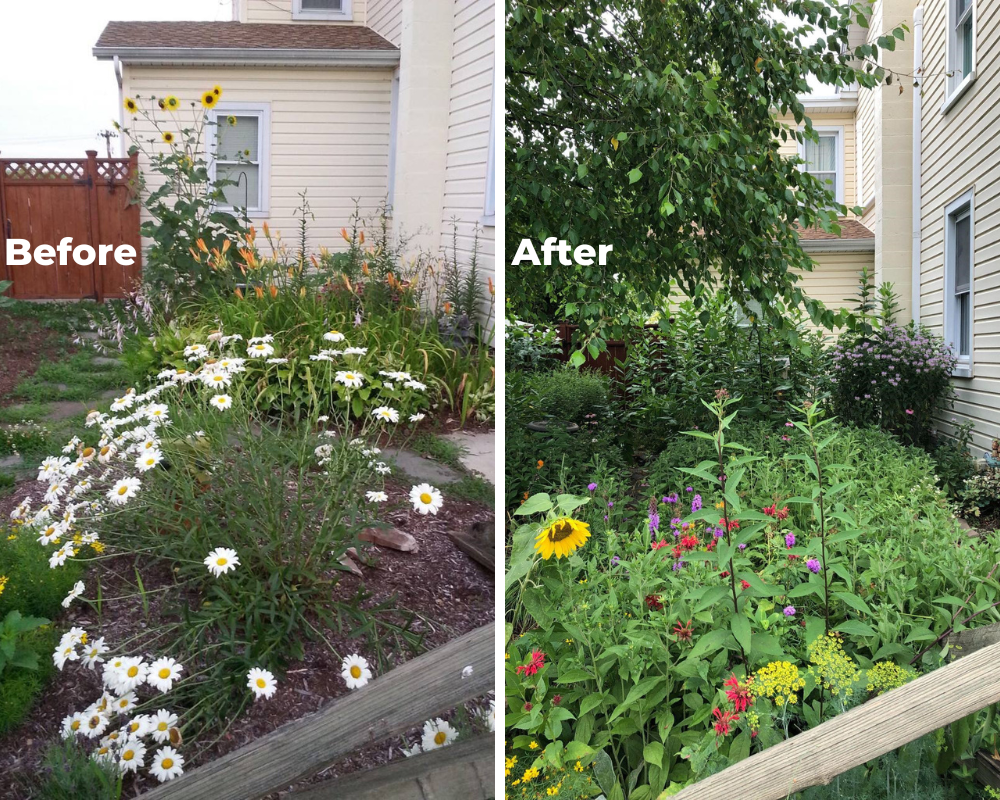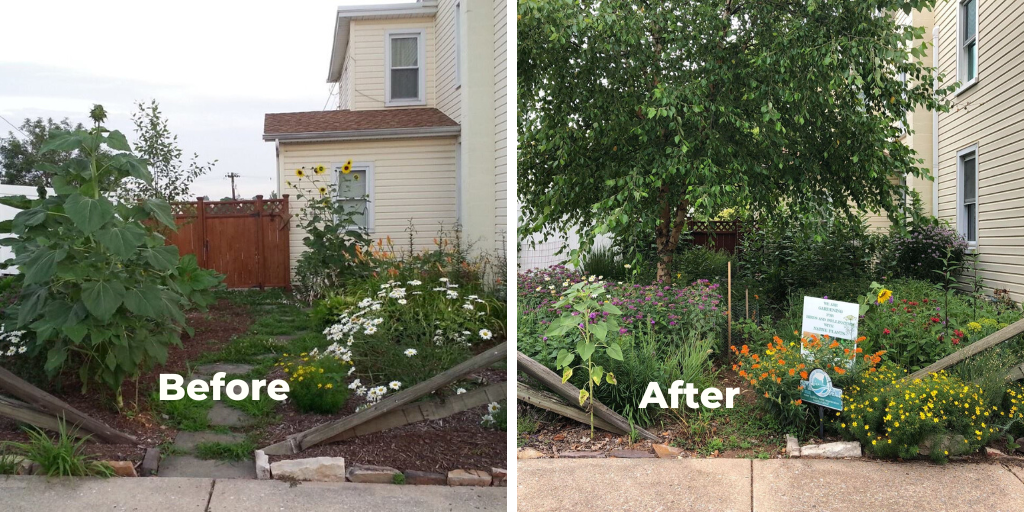Since colonization, Americans have been importing plants from Europe and Asia. In addition, throughout the 1900s, the turf grass lawn was marketed heavily and accepted as a status symbol and then ordinary. Today when you go to most garden centers, the majority of plants, trees, and shrubs you see aren’t native to the United States, and mowing equipment is prominently displayed.
However, many nonnative plants are invasive, because they have traits that make them very adaptable and they have few or no natural predators here. They take over areas, crowding out native plants and thereby displacing the food sources and habitat that native insects, birds, and other wildlife rely on. Mowed lawns likewise offer little food and habitat to native insects and animals.
Biodiversity loss and the decline of ecosystems are threats to all living beings. The challenges we face in restoring biodiversity can seem overwhelming. Education is the first step to becoming part of the solution.
I’m not an expert on native plants, biodiversity, or habitats. I’m simply a homeowner who realized I like to see the peaceful flight of a butterfly among flowers in the afternoon and the flashes of lightning bugs deep into a summer evening. I’d rather enjoy a morning cup of coffee on my porch, surrounded by the fragrance of common milkweed and watching a robin feed its young than cut grass with a noisy lawn mower, inhaling fumes. My husband has the same view. This is why we killed our lawn and created a native garden in its place.
Replacing Our Yard with a No-Mow Garden of Native Species
Our desire to become part of the solution to the loss of native biodiversity and habitat began in 2016 when we stood in our quarter-acre suburban lot in southcentral Pennsylvania and took stock of what we had.
Our yard had pretty much everything that had originally been there when we purchased our home: turf grass, barberry bushes, burning bushes, hosta, English ivy, daylilies, two dying dogwood trees, and some eastern hemlocks. Of these, only the dogwoods and hemlocks were native species. We committed to replacing the grass and non-native plants with native plants, shrubs, and trees.
While our interest level was high, our knowledge base was not! So from the start of the project, we sought information and advice from local native plant nurseries, the local Penn State Extension Master Gardener program, and friends who had established native plant gardens.
We also found the U.S. Department of Agriculture plant database very helpful. Accessing it through our phones on native plant shopping expeditions, we were able to make informed decisions on the go. We even scored some clearance plants at a box store when I thought I recognized the plant name as a native species and used the USDA site to confirm it. The site allows you to search using the scientific name as well as the common name and has photos of the plants in various stages of growth.
Our first step was to plant trees. After assessing our property size and the proximity of utility poles and buried lines, we decided on clumping river birch. We placed them where they get rooftop stormwater via rerouted rain spouting. As the trees have grown, the lack of sunlight under them has helped eliminate turf grass. We also allow leaf litter to accumulate, since it’s vital habitat for many species and we avoid spending time and money to remove it.
Removing the daylilies and hostas took more than one growing season. As I researched what plants would do well in our yard, I kept my eyes open for native plant sales and kept in touch with friends who had plants to share. As plants became available, I removed hostas and daylilies to make room.
Six years later, we are turf grass free, and our quarter-acre lot is a biodiverse ecosystem of mainly native plants, trees, and shrubs, along with the birds and pollinators and other insects that depend on them.

In 2016, this part of our yard consisted of non-native daisies, hostas, day lilies, tiger lilies, and (not visible) English ivy. In July 2022, the same part of our yard, with a river birch tree, common milkweed, butterfly weed, liatris, monarda, coreopsis, ironweed, golden alexander, switchgrass, little bluestem, and purple love grass. Not yet blooming: asters, goldenrod, coneflowers and black-eyed susans. Also present but not visible in the photo are cup plants, mountain mint, and small serviceberry and redbud trees.
Positive Results
Here are some of the benefits we’ve experienced from replacing our yard with a no-mow native garden:
- We’re seeing more butterflies and bees than before, helping to sustain pollinators, and providing food and habitat for birds and other wildlife.
- We’re decreasing stormwater runoff and the chemicals and other pollution it carries to our local stream.
- With trees near the house, we’re reducing heating and cooling costs.
- We save money by not buying fertilizers, herbicides, or insecticides.
- We decreased noise pollution, because we don’t use a lawn mower or weed whacker.
- Our neighbors have responded favorably to the change, and we enjoy opportunities to share our knowledge with them. One neighbor asked for suggestions for their yard and asked, “could we make our yard a forest too?”
In addition, we simply enjoy our outdoor space more. Sitting outside and from every window in our home, we can see the results of our efforts. The changes in the garden throughout the year are inspiring and fascinating. In the summer, it’s like an amusement park for wild creatures, with constant activity. Summer is also the season when we see holes in the leaves and know we’re providing food sources for insects. In autumn, the colors of the trees, asters, sunflowers, and goldenrod create an illusion of warmth as the temperatures drop. In the winter, the stems and branches laden with snow and ice look like sculptures. Spring is a time for discovery, as we see which plants have spread to a new yard area.
Tips for Going No-Mow Native
In the past 10 years, there’s been an explosion of information on planting native species, including online resources and many books. I highly recommend any book by Doug Tallamy. Here are a few tips from my own experience:
- If you have neighbors close by, let them know in advance what you’re planning for your yard. Offer them plants when you have an abundance. Be respectful of property lines. One of our neighbors was concerned about twigs in her yard from our trees but was satisfied when I told her she could simply throw them over the fence and we’d take care of them.
- Your yard doesn’t have to be 100 percent native species. Not all non-native plants are invasive.
- Find fellow native plant enthusiasts and trade plants. Some will be happy just to give you some without a trade. There are groups on social media, Master Watershed Stewards are a great resource, and county and state parks often have native plant sales. I’ve never met a native plant enthusiast who wasn’t thrilled to share their knowledge.
- Don’t tackle the entire yard in one season or year. Break it down into manageable portions.
- Remember that perennials take about three years to establish. The first year, they sleep. The second year, they creep. In the third year, they leap.
- Realize that the space you choose for a perennial might not be where it’s happiest. The plant will move to the space best for it.
- Keep in mind that young trees will grow and create new shaded spaces.
- Although you won’t need to mow, you’ll likely have to pull weeds occasionally. I’m selective and often identify a plant before I consider it a “weed” that has to be removed. For example, dog bane and pearly everlasting are two “weeds” that I allow in my yard.
- There should be holes in the leaves. There should be nibbling on the stems. If you don’t see evidence of something eating your plants in your garden, you’ve planted the wrong plants.
- Document your progress with photos. You’ll be amazed at the transformation.
- Several organizations offer backyard habitat certification programs, if you’re interested. In 2020, we had our yard certified by the Nurture Nature Center and Penn State Extension Master Watershed Stewards Watershed-Friendly Property Certification Program.
